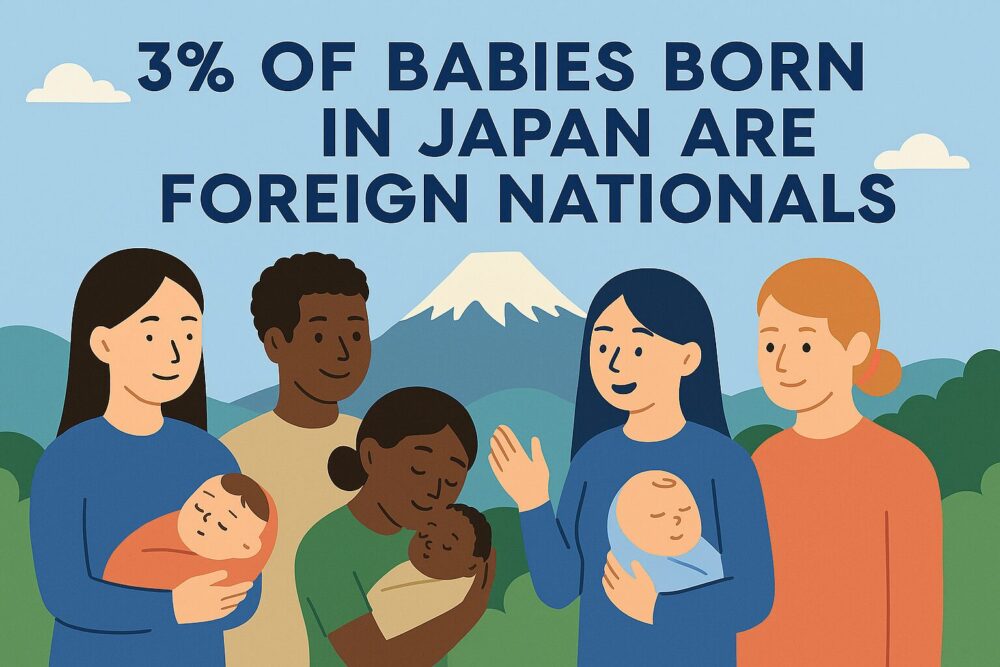For the first time in Japan’s recorded history, more than 20,000 babies born in a single year were of foreign nationality. In 2024, foreign newborns accounted for 3.2% of all births in the country—a symbolic milestone that reflects Japan’s shifting demographics and the growing presence of international residents.
- A New Stage in Japan’s Demographic Shift
- Who Are Japan’s Foreign Mothers?
- Young Foreign Residents Are Driving the Trend
- Local Governments Respond: The Case of Nishio City
- Toward a More Inclusive Japan
- Narita City Publishes Multilingual Etiquette Guide as Foreign Births Rise
- <Afterword>
Toward a More Inclusive Japan: Bridging Cultures Through Mutual Effort
A New Stage in Japan’s Demographic Shift
According to the Ministry of Health, Labour and Welfare, 22,878 babies born in Japan in 2024 were classified as “foreign,” meaning both parents were non-Japanese or the mother was a foreign national in the case of non-marital births. This marks a 1.5-fold increase compared to a decade ago.
Meanwhile, Japanese births declined to 686,173—a drop of over 41,000 from the previous year. The rise in foreign births offset more than half of that decline, signaling a new phase in which international families are helping to sustain Japan’s shrinking population.
Who Are Japan’s Foreign Mothers?
By nationality of the mother:
- China: 4,237 births
- Philippines: 1,807 births
- Brazil: 1,351 births
- “Other countries” (including Vietnam, Nepal, etc.): 14,425 births
The “Other” category was the largest, reflecting the diversity of Japan’s foreign resident population
Young Foreign Residents Are Driving the Trend
Japan’s foreign resident population reached a record 3.77 million by the end of 2024, about 3% of the total population. Over 56% are in their 20s and 30s, many of whom came for work or study. As more of them settle long-term, the number of foreign births is expected to continue rising.
Local Governments Respond: The Case of Nishio City
Some municipalities are already seeing foreign births exceed 10%. In Nishio City, Aichi Prefecture, 14% of all babies born in 2024 were of foreign nationality. The city is home to residents from over 50 countries, including Vietnam and Brazil.
To support these families:
- The city hired interpreters fluent in Portuguese and Vietnamese
- Hosted multilingual school orientation sessions
- Offers Japanese language education for preschoolers
- Plans to strengthen disaster response and build bridges between Japanese and foreign residents
Toward a More Inclusive Japan
As Japan enters a new demographic era, immigration policy must evolve beyond regulation. Coexistence, inclusion, and multilingual support will be key to ensuring that foreign families can thrive—and that Japan can sustain its future.
Narita City Publishes Multilingual Etiquette Guide as Foreign Births Rise
Introduction
In Narita City, Chiba Prefecture, the number of babies born to foreign nationals in 2024 was 1.6 times higher than in 2020. As more long-term foreign residents begin raising families in Japan, the city is responding with a practical and inclusive initiative: a multilingual “Manner Book” designed to help newcomers adapt to local customs and daily life.
What’s in the Manner Book?
The guide covers essential aspects of Japanese etiquette, including:
- How to sort and dispose of garbage
- Noise prevention and consideration for neighbors
- Tips for harmonious living in residential communities
Available in multiple languages, the booklet aims to foster mutual understanding and help foreign residents integrate into the local community.
You can view the official PDF here.
A Demographic Shift Japan Can’t Ignore
As Japan’s working-age population continues to decline, the country faces an inevitable increase in foreign labor and long-term residency. Narita’s initiative reflects a broader national reality: foreign residents are no longer temporary visitors—they’re becoming part of Japan’s social fabric.
Toward Sustainable Coexistence
Narita’s approach goes beyond regulation. By offering multilingual resources and promoting everyday etiquette, the city is laying the groundwork for a more inclusive and cooperative society. It’s a model that other municipalities may soon follow as Japan enters a new demographic era.
Source: Nikkei. (2025, October 8). 3% of Babies Born in Japan Are Foreign National
https://www.nikkei.com/article/DGXZQOUA303760Q5A930C2000000
<Afterword>
Toward a More Inclusive Japan: Bridging Cultures Through Mutual Effort
The birth rate among foreign nationals in Japan is expected to continue rising in the coming years. As international families become a more prominent part of Japanese society, it is essential to build an environment where both Japanese and foreign residents can live comfortably and respectfully.
This cannot be achieved through one-sided expectations. Rather than placing the entire burden on foreign residents to master the Japanese language and adapt to local customs, Japan itself must also make efforts to improve English proficiency and deepen cross-cultural understanding.
The language barrier remains significant, but today’s translation technologies—such as advanced mobile apps—have made communication more accessible than ever. By fully leveraging IT tools and embracing mutual adaptation, Japan can create a more inclusive and sustainable environment for all.

